The Science of Joy: How Dopamine, Oxytocin, Serotonin, and Endorphins Influence Your Mood
August 7, 2023
 1384
1384 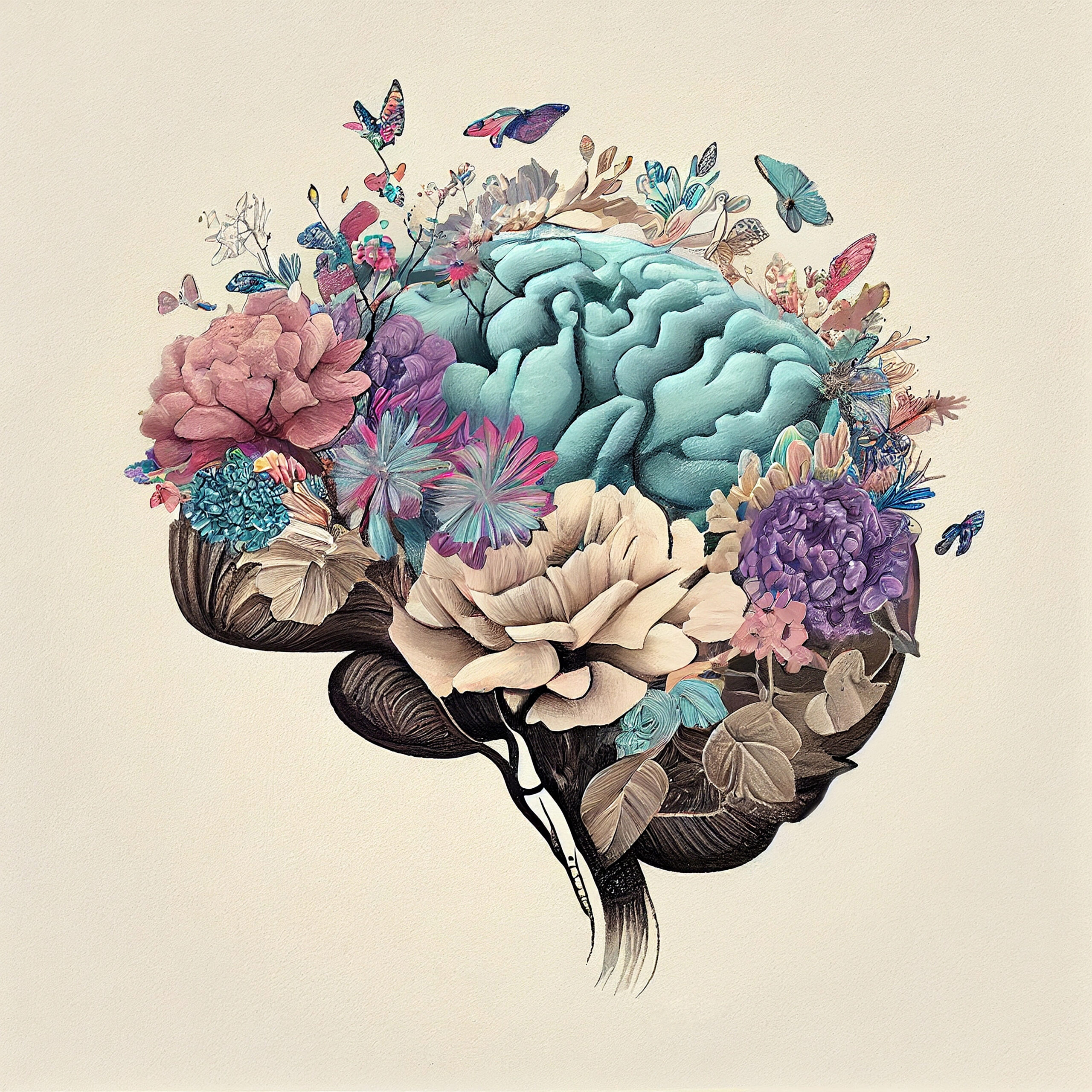
Written By: Jack Riess NASM Certified Personal Trainer, Author, and Life Long Researcher of Health and Longevity.
What if I told you that the secrets to happiness were already inside your head, quite literally?
It’s true!
Tucked away within the intricate labyrinth of our minds, a quartet of chemicals plays a pivotal role in determining our moods, and consequently, our sense of happiness.
Welcome to the fascinating world of neurochemistry, where every emotion you experience is the result of a delicate ballet of neurotransmitters dancing across your brain.
The stars of our show today are none other than dopamine, oxytocin, serotonin, and endorphins—collectively, let’s call them the “Happiness Quartet.”

They hold the keys to our inner joy, contentment, and peace.
Each one is responsible for different aspects of our emotional well-being, from the satisfaction of achieving a goal to the warmth of a loved one’s hug, from the bliss of basking in the morning sun to the exhilaration of a good workout.
Dopamine, fondly dubbed the “Reward Molecule,” plays the applause when you check off tasks on your to-do list or relish your favorite treat.
Oxytocin, or the “Love Hormone,” wraps you in a comforting blanket during moments of deep emotional bonding.
Serotonin, the “Mood Stabilizer,” maintains the background music, ensuring the rhythm of well-being remains steady, affecting our mood, appetite, and sleep.
Lastly, but by no means the least, endorphins, our natural “Painkillers,” offer the grand finale, stepping in to help us power through stress and discomfort, allowing us to feel a sense of euphoria even in physically taxing situations.
Think of these chemicals as the conductors of your personal happiness orchestra.
When they’re harmonizing well, life feels like a beautiful symphony. But what happens when they’re out of tune?
And more importantly, how can you ‘conduct’ these chemicals to craft a happier, healthier life for yourself?
Let’s embark on this intriguing journey together and find out!
Dopamine: The Reward Molecule
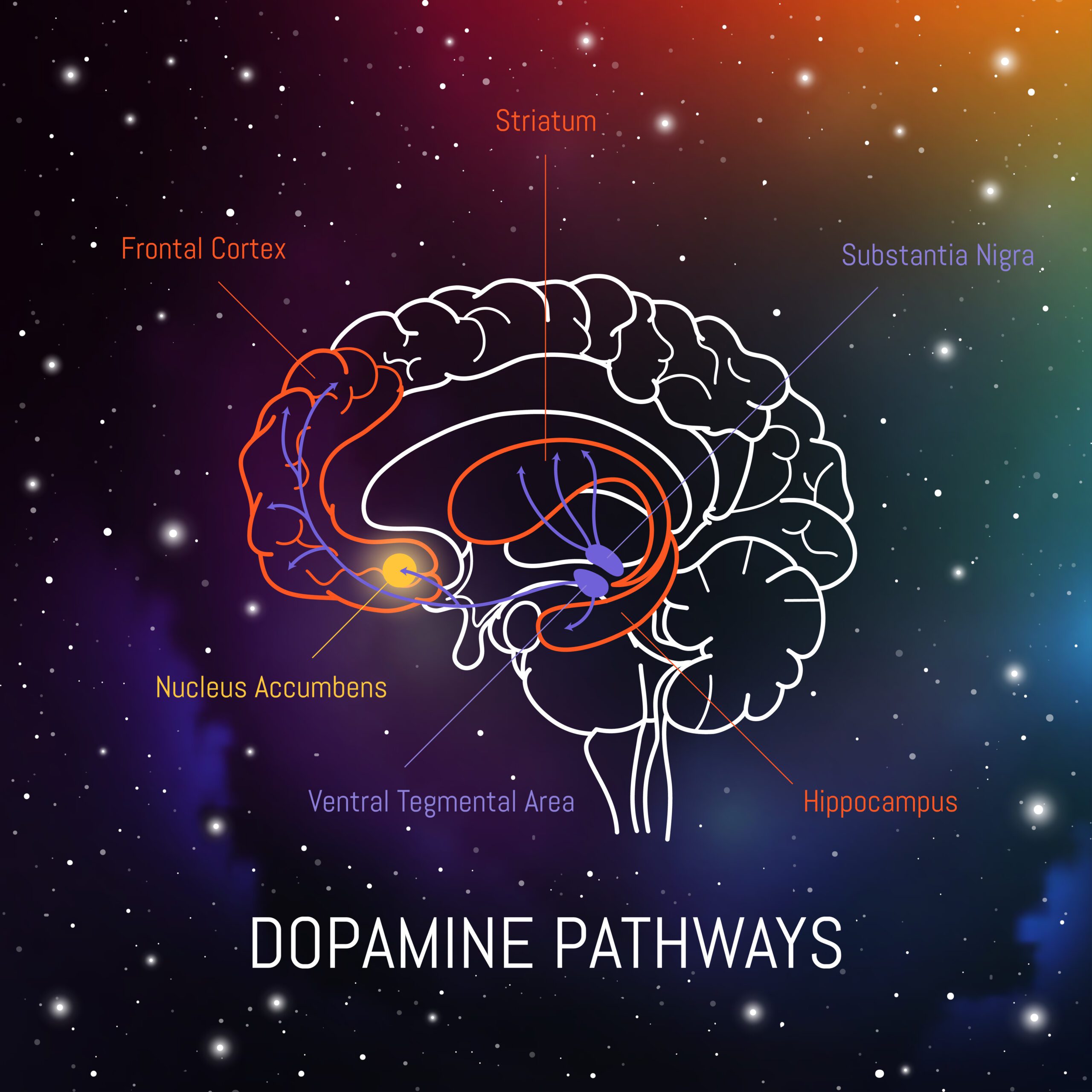
The first virtuoso in our “Happiness Quartet” is Dopamine, often dubbed the “Reward Molecule.”
This brain chemical serves a crucial role in how we perceive and pursue rewards.
It’s a neurotransmitter, a type of molecule that transmits signals from a neuron to various cells within the body, helping to coordinate both our actions and emotional responses.
Dopamine is an integral part of the brain’s reward system.
It is released when your brain is expecting a reward. When you score a goal, solve a puzzle, or indulge in your favorite meal, you experience a rush of pleasure – that’s dopamine at work!
It’s not just about enjoying the reward itself, but dopamine fuels the motivation that gets us to chase after these rewards, adding a little zest to life.
While the thrill of accomplishment is a common dopamine trigger, there are a host of other activities that can help keep your dopamine levels buoyant.
A delicious meal, particularly those rich in protein, can stimulate dopamine production, as certain amino acids found in protein-rich foods are precursors to dopamine.
Music, too, has a powerful effect on our dopamine levels.
Ever felt chills down your spine when your favorite song comes on?
That’s a dopamine spike!
Meditation and sufficient sleep are other often-overlooked activities that help regulate your dopamine levels, contributing to a positive mood and a more focused mind.
However, like anything in life, balance is key.
Dopamine deficiency can lead to feelings of apathy, lack of motivation, and even depression.
On the other hand, an overload can result in overexcitement, restlessness, and can contribute to various disorders, including addiction.
The pursuit of dopamine-triggering behaviors can sometimes lead us down a path of unhealthy habits, such as overeating or substance abuse, as we chase that next dopamine hit.
So, how can we ensure we’re maintaining healthy dopamine levels?
Firstly, setting achievable goals can lead to a healthy flow of dopamine, reinforcing a positive cycle of task, completion, and reward.
Regular exercise is another great way to naturally boost your dopamine levels.
Incorporating a balanced diet, rich in lean proteins, fruits, and vegetables, ensures you have the necessary precursors for dopamine production.
Regular meditation and good sleep hygiene contribute to balanced dopamine levels and an overall sense of well-being.
Lastly, try to cultivate awareness of your actions and their motives, ensuring they’re not just a blind chase for the next dopamine rush.
In essence, dopamine, our delightful “Reward Molecule,” is a key player in our happiness.
By understanding its role and how to regulate its production, we can keep our internal symphony harmonious and our outlook on life upbeat.
Oxytocin: The Love Hormone
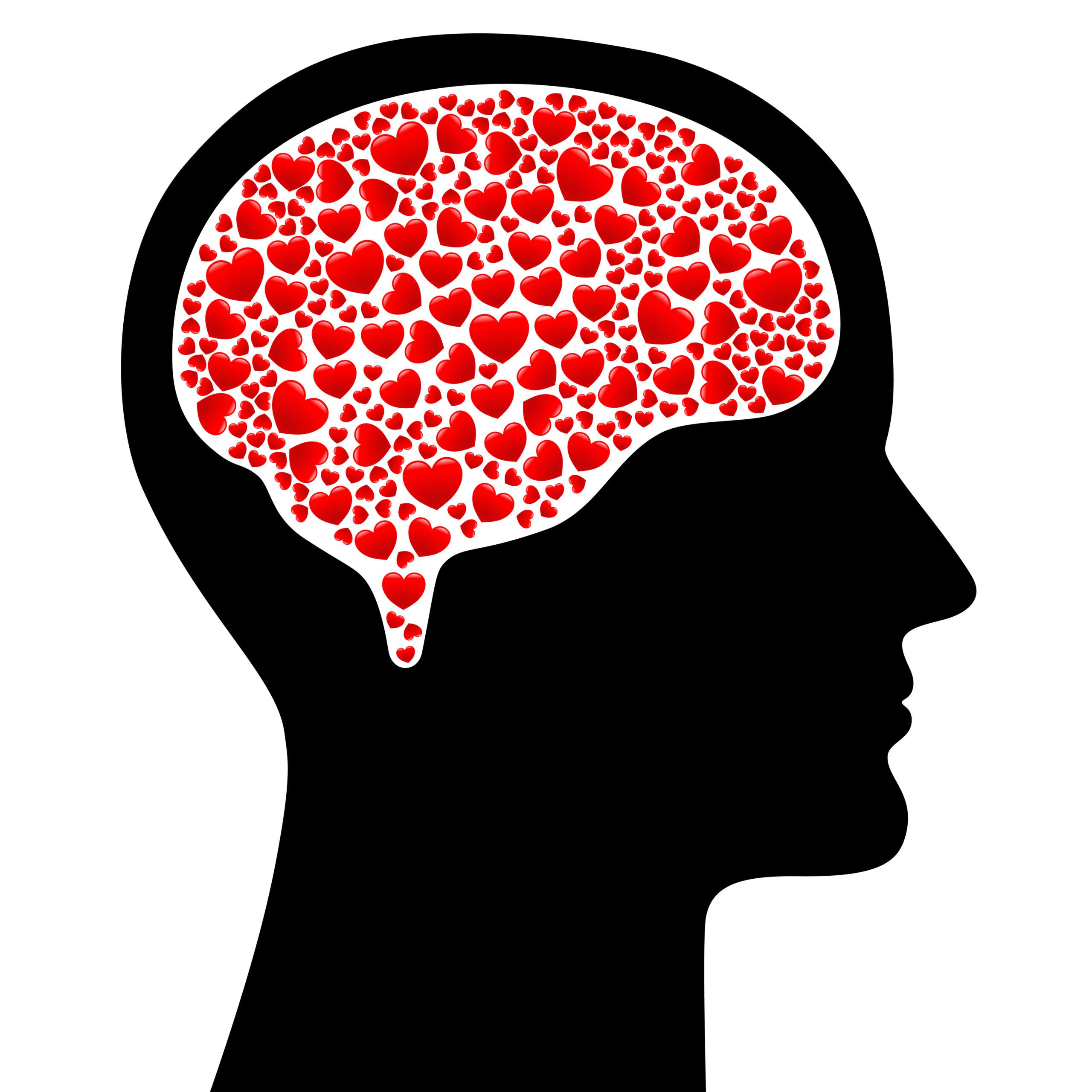
The second maestro of our “Happiness Quartet” is Oxytocin, endearingly termed the “Love Hormone.”
A multifaceted molecule, oxytocin is a hormone and neurotransmitter that plays a pivotal role in a range of social and emotional behaviors.
Oxytocin forms the glue of our social bonds, it builds bridges of trust, and it’s the warmth in our relationships.
It’s released in our bodies during intimate moments, whether they’re between romantic partners, among close friends, or even in the bond between a mother and her child.
Oxytocin fuels our sense of connection with others, and it’s this profound feeling of unity and affection that makes oxytocin a star player in our happiness ensemble.
Playing with a pet might boost your oxytocin levels, but there are many more melodies in the oxytocin symphony.
Sharing a warm hug, giving or receiving a gift, lending a helping hand, or even just holding hands can all trigger oxytocin release.
This is why acts of kindness, whether big or small, can be so fulfilling – they don’t just lift the spirits of those you’re helping, but your own as well.
Yet, the beautiful music of oxytocin isn’t without its discordant notes.
An imbalance in this hormone can lead to issues.
Deficiency might contribute to feelings of loneliness, difficulty in forming close relationships, and might even play a role in conditions like depression.
Conversely, an excess might result in overly trusting behavior, making one susceptible to manipulation or deceit.
So how can we keep our oxytocin levels in harmony?
It’s about embracing love and connection in our lives. Regular physical affection, like hugging or holding hands, boosts oxytocin.
Spend quality time with loved ones – friends, family, or pets. Practice acts of kindness and empathy, whether that’s volunteering for a cause you believe in or simply lending an ear to a friend in need.
Finally, mindfulness and relaxation exercises can also support healthy oxytocin levels, fostering a deep connection with oneself and with the world around.
With the right balance, oxytocin can help conduct the symphony of our social lives, making our interactions more fulfilling and our relationships deeper.
So here’s to more hugs, acts of kindness, and bonding – let’s let the “Love Hormone” sing!
Serotonin: The Mood Stabilizer
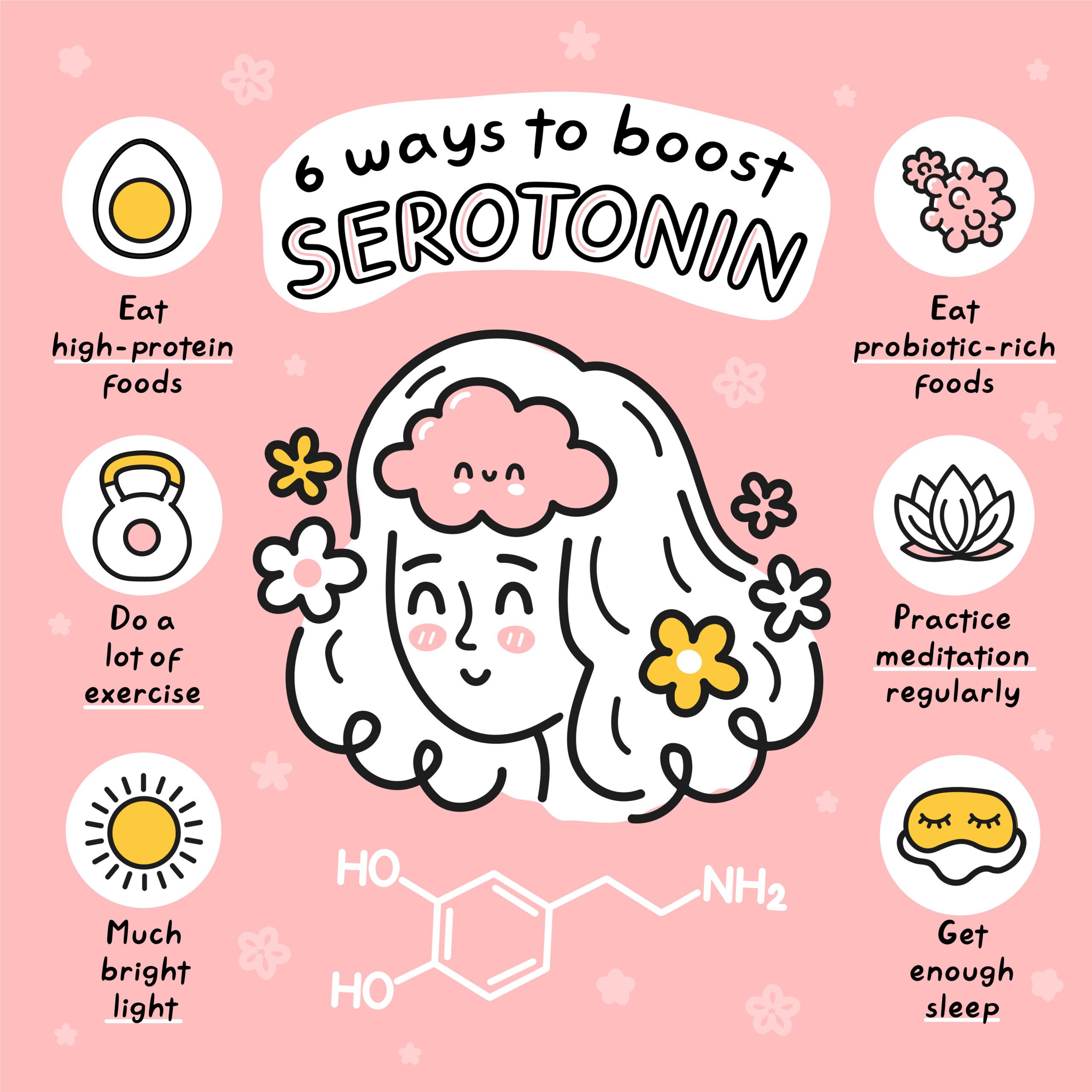
Now, let’s introduce the third virtuoso in our “Happiness Quartet”: Serotonin, often referred to as the “Mood Stabilizer.”
This neurotransmitter has a profound influence on our emotional and physical functioning, holding sway over our mood, appetite, sleep, and even cognitive functions like memory and learning.
Serotonin is like the steady rhythm in the backdrop of our symphony of emotions.
When we’re feeling happy, relaxed, and self-confident, it’s often because our serotonin levels are in perfect balance.
This incredible neurotransmitter helps regulate our mood, preventing it from dipping too low, and it also curbs our appetite, ensuring we’re hungry at the right times.
And when it comes to sleep, serotonin is the lullaby that guides us into a restful slumber, playing a critical role in our sleep cycle.
It’s true that sun exposure can boost serotonin levels, but that’s not the only tune in serotonin’s repertoire.
Consuming foods rich in tryptophan – an amino acid that the body converts into serotonin – can lead to increased serotonin production.
Such foods include eggs, cheese, tofu, nuts, and lean meats.
Practicing mindfulness and meditation can also help boost serotonin levels, providing an internal sunbath that brightens our mood regardless of the weather.
However, as with all things, harmony is essential.
Serotonin deficiency can lead to feelings of sadness, low self-esteem, anxiety, insomnia, and even depression.
On the other hand, an excess of serotonin can result in a condition known as Serotonin Syndrome, characterized by agitation, restlessness, confusion, rapid heart rate, and high blood pressure.
So how do we keep the serotonin symphony in balance?
Maintaining a balanced diet is key, especially one rich in foods with tryptophan.
Regular exercise can also increase your brain’s serotonin levels, improving your mood and energy.
Ensuring enough exposure to natural light can help, so try to spend some time outdoors every day, weather permitting.
Practicing mindfulness and meditation, along with getting enough restful sleep, are also crucial for maintaining a healthy serotonin balance.
Serotonin, our magnificent “Mood Stabilizer,” conducts the rhythm of our emotional life.
By understanding its functions and ways to maintain its balance, we can ensure that our internal symphony plays a tune of calm, contentment, and well-being.
Endorphins: The Natural Painkillers
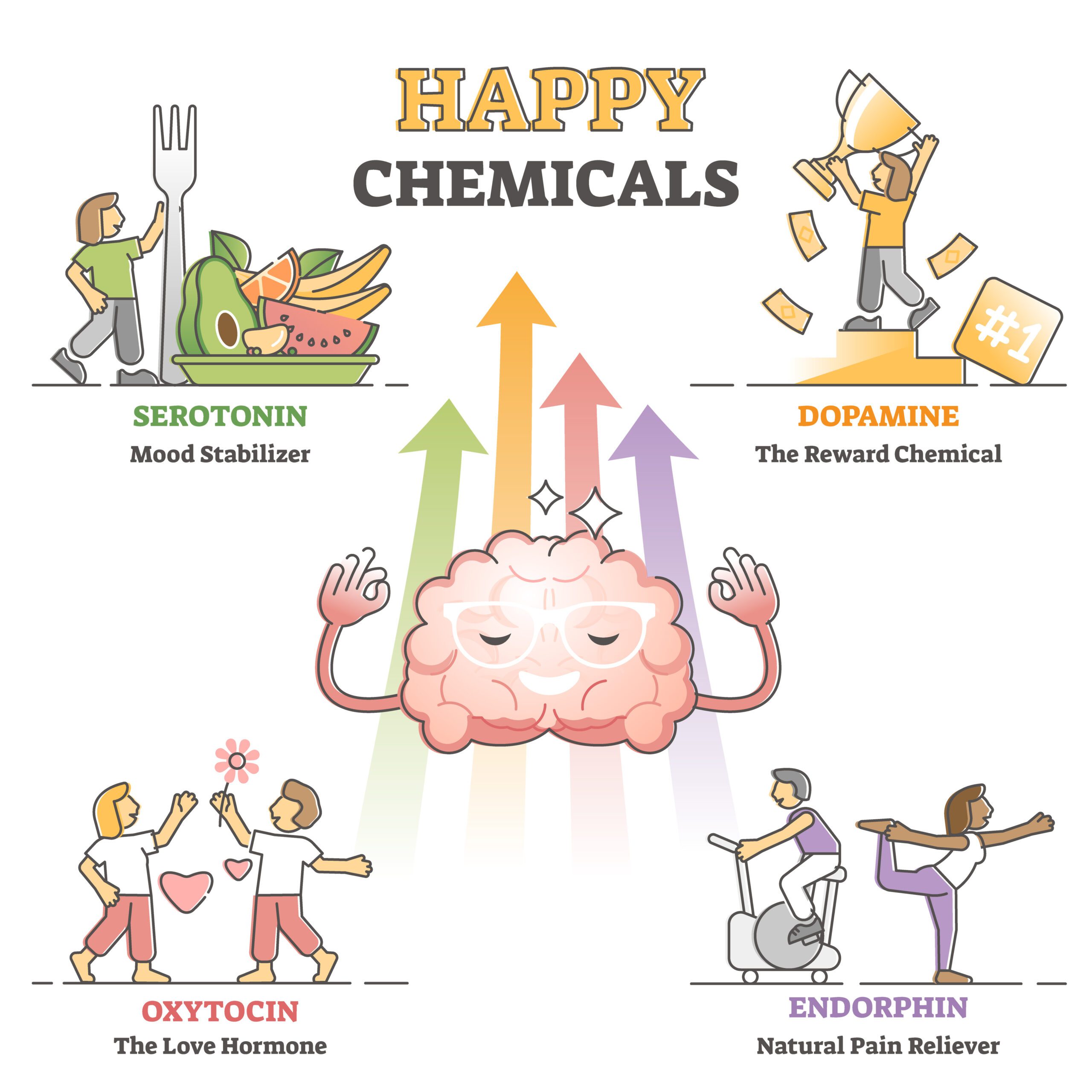
The final member of our “Happiness Quartet” is Endorphins, often referred to as the “Natural Painkillers.”
Endorphins are neurotransmitters, released by the pituitary gland, known for their powerful pain-relieving and stress-reducing properties.
They’re our body’s natural opiates, designed to alleviate physical discomfort and contribute to feelings of pleasure and satisfaction.
Endorphins serve as our body’s natural defense mechanism against stress and pain.
They come to our aid like an expertly played soothing melody during physical exertion, injury, or emotional distress, reducing the perception of pain and bringing a sense of calm and comfort.
It’s the surge of endorphins that gives us the famed “runner’s high” – a feeling of euphoria and a surge in positive mood following intense exercise.
Exercise is a common way to release endorphins, but there are many other ways to trigger their release.
Laughter truly can be the best medicine, as a good belly laugh can result in a rush of endorphins.
Consuming spicy foods can also lead to a release of endorphins, as a response to the mild “pain” of the heat.
Even the anticipation of a good chuckle or a spicy meal can start to get the endorphins flowing.
However, as with the other neurotransmitters in our quartet, balance is key.
Endorphin deficiency can contribute to feelings of chronic pain, depression, and anxiety.
Meanwhile, excessive pursuit of endorphin-releasing activities, such as extreme sports or overeating spicy food, can lead to addiction and other health issues due to the repeated pursuit of that endorphin high.
So, how can we maintain a harmonious endorphin level?
Engage in regular, moderate exercise, as it can help release endorphins and keep your mood elevated.
Incorporate laughter into your daily life, whether through a funny movie, jokes with friends, or even laughter yoga.
Enjoying your favorite spicy dish can also give a quick boost.
Furthermore, meditation and deep-breathing exercises can help stimulate endorphin release, helping you manage stress and discomfort more effectively.
Endorphins, our soothing “Natural Painkillers,” are key players in our happiness and well-being.
Understanding their role and how to promote their healthy production can help us navigate life’s ups and downs with a little more ease and a lot more smiles.
So here’s to the power of laughter, the joy of movement, and the pleasure of a spicy meal – let’s let the endorphins play!
Harmonizing Your Happiness Hormones

Our journey through the remarkable world of our brain’s “Happiness Quartet” – Dopamine, Oxytocin, Serotonin, and Endorphins – has unveiled how each of these chemicals contributes to our unique symphony of emotions.
From the exuberant peaks of the “Reward Molecule” dopamine to the comforting strains of the “Natural Painkiller” endorphins, each neurotransmitter plays its part in our overall well-being.
Crucially, these chemical maestros do not work in isolation.
Like the interconnected notes of a symphony, they complement and harmonize with one another.
The exhilaration of a dopamine rush from accomplishing a goal can lead to the affectionate release of oxytocin when you share your success with a loved one.
The serene rhythm of serotonin, set right by a good night’s sleep, can help keep you in the perfect mood to relish the endorphin-releasing joy of a hearty laugh the next day.
Having all four chemicals in balance can create a beautiful melody in our lives.
Enhanced mood, reduced stress, better relationships, improved mental strength, and overall happiness can be the glorious chorus of this symphony.
As we close this exploration, remember that maintaining this harmony isn’t a one-time event; it’s a life-long symphony.
Every activity, interaction, and choice can influence this delicate balance.
Set achievable goals, embrace love and connection, maintain a balanced diet, exercise regularly, laugh often, and keep your mind at peace.
These are not just the keynotes of a healthy, happy life, but they’re the music to our ears – the harmonious performance of our brain’s “Happiness Quartet.”
So, let’s make some music.
Let’s make some happiness.
Let your quartet play, and let’s conduct the symphony of our lives with grace, balance, and joy.
After all, the key to happiness might just be all in our heads 🙂

A new study suggests that a widely used sugar substitute found in diet sodas, chewing gum, and low-sugar yogurt may elevate insulin levels. This could increase the long-term risk of heart disease. “Artificial sweeteners have infiltrated nearly all types of food, making it crucial to understand their long-term health effects,” said Yihai Cao, senior author […]

Diet Coke has long been a fan-favorite among soda lovers who want a fizzy, guilt-free alternative to traditional soft drinks. While its zero-calorie, zero-sugar label makes it seem like a healthier option, the reality is far more concerning. Despite its undeniable popularity, Diet Coke’s nutritional profile has raised red flags among health experts for years. […]

New study shows that embracing an anti-inflammatory, plant-forward diet can support cognitive function and help reduce the risk of dementia. What You Eat Shapes Your Brain The food you eat doesn’t just impact your body—it also affects your brain. Research suggests that eating an anti-inflammatory, plant-based diet can help improve memory, focus, and overall brain […]